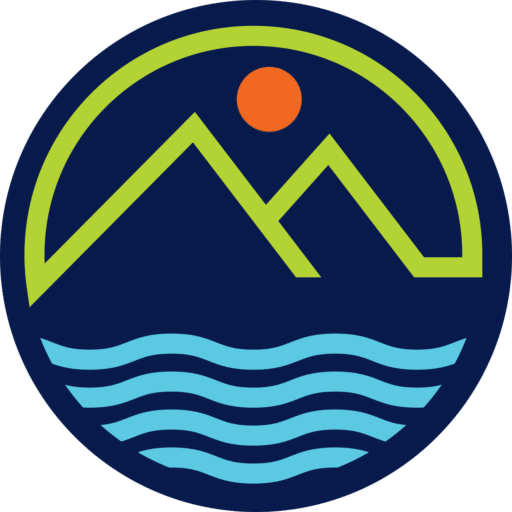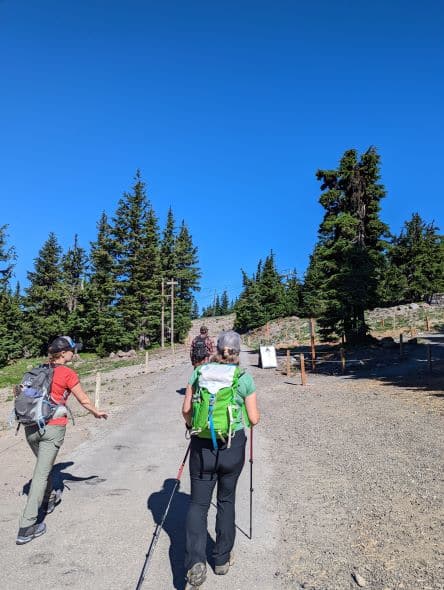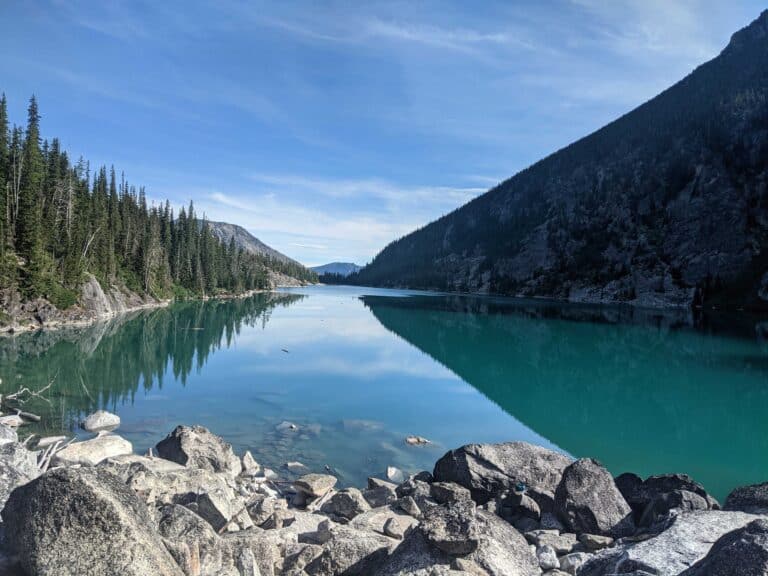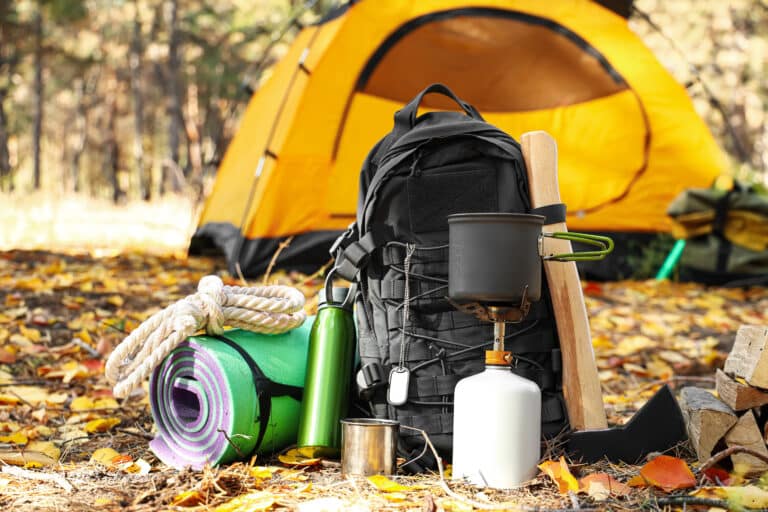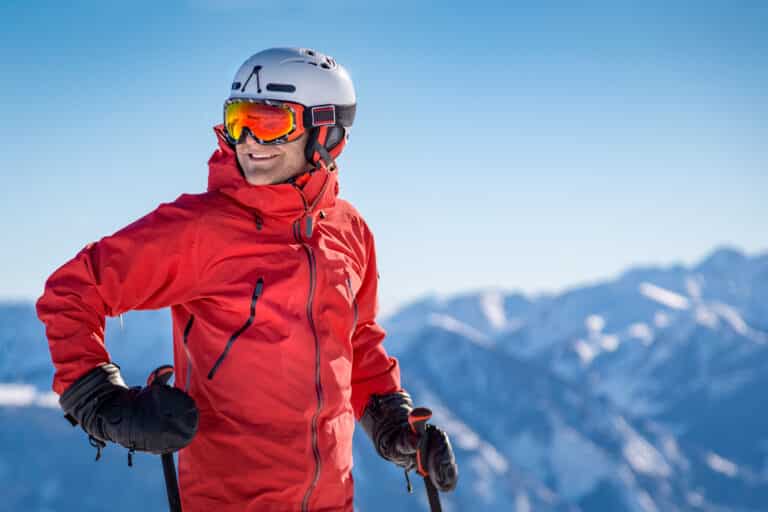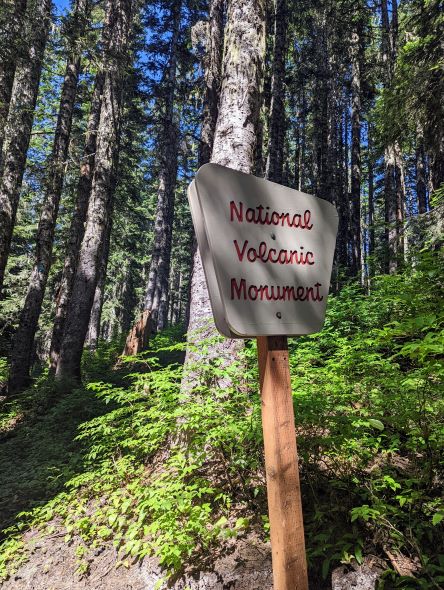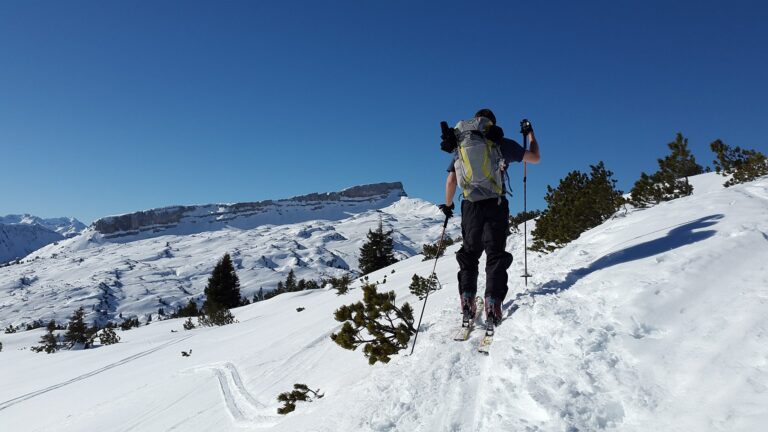Backcountry Skiing Time: Unbelievably Amazing Western US Winter Camping
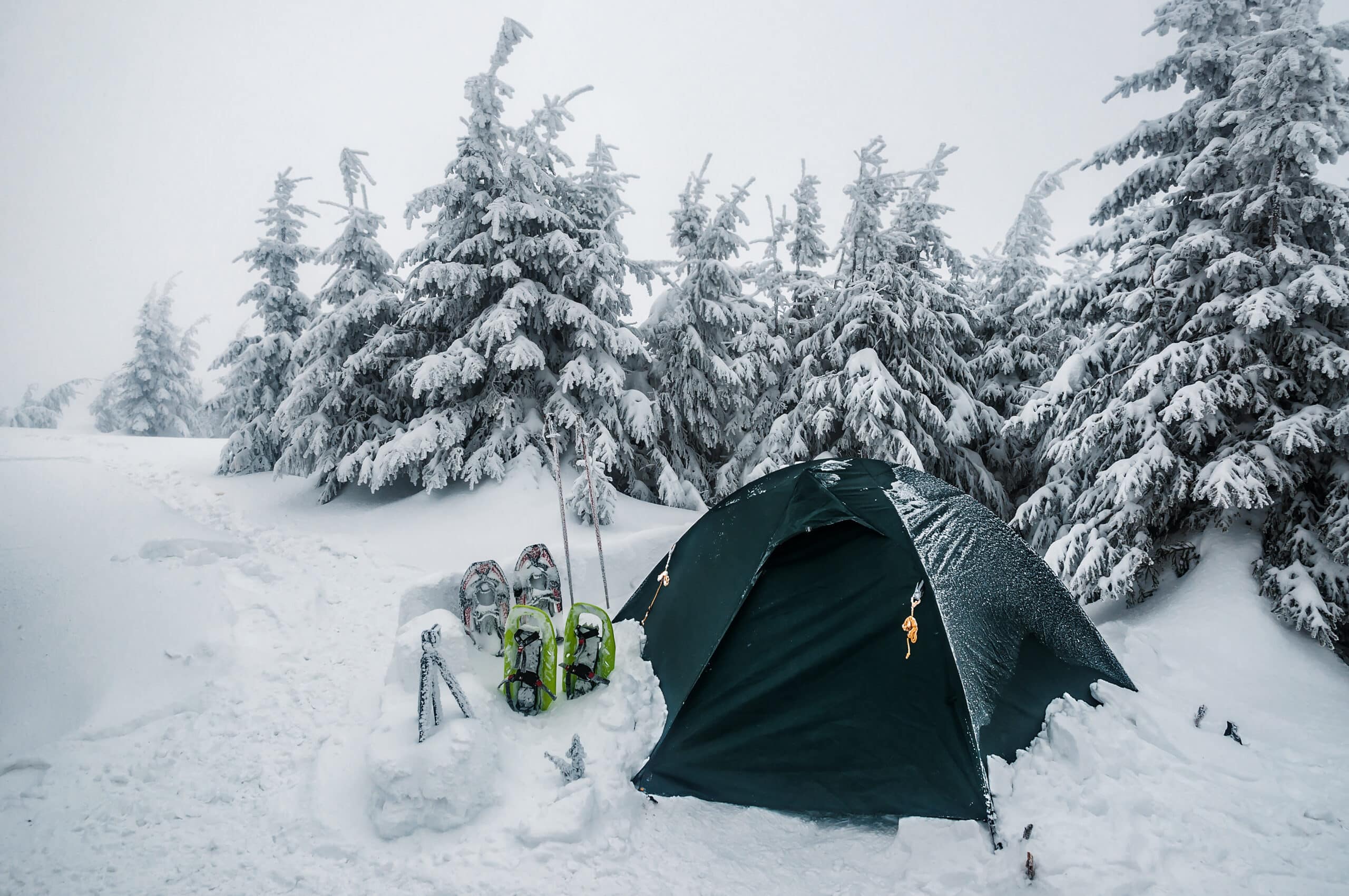
Our content may include affiliate links, through which we earn a small commission on purchases. Want to learn more about us? Read here.
The Western United States is a vast and diverse playground for outdoor enthusiasts, offering many backcountry skiing and winter camping opportunities. From the towering peaks of the Rockies to the volcanic wonders of California, this region is a winter wonderland waiting to be explored.
From the serene landscapes of Lassen Volcanic National Park to the deep powder of Utah’s Wasatch Mountains, each destination in the Western United States promises a unique blend of adventure and natural beauty.
So, gear up and get ready to embark on a journey through these winter wonderlands, where backcountry skiing and camping await those who seek the thrill of the great outdoors. This guide will take you on a virtual tour of some of the most captivating backcountry skiing and camping destinations in the Western United States.
Colorado’s San Juan Mountains
The San Juan Mountains in southwestern Colorado offer numerous backcountry skiing and camping options. Places like the Telluride area, Red Mountain Pass, and the Silverton backcountry provide challenging terrain and stunning views.
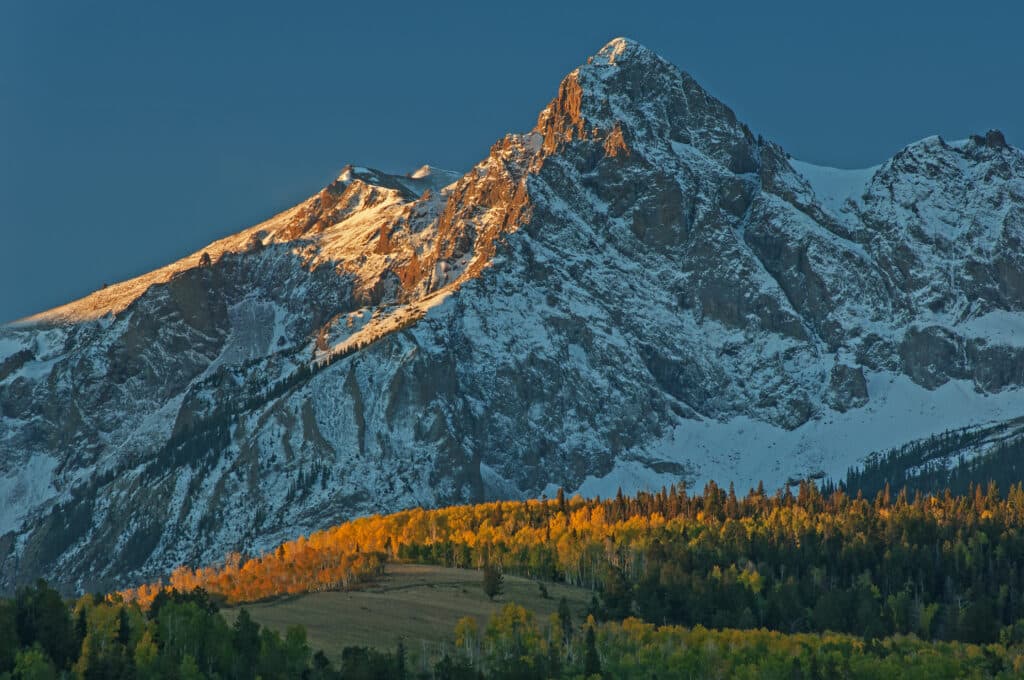
If you’re a winter sports enthusiast hunting for an epic adventure, the San Juan Mountains should be at the top of your must-visit list. Located in the southwestern part of the state, the San Juan Mountains offer a backcountry skiing and camping experience that’s second to none.
With rugged terrain, challenging runs, and awe-inspiring vistas, this region has everything you need for an unforgettable outdoor escapade.
Telluride Area: Powder Paradise
First stop on your San Juan journey? The Telluride area. Nestled in a picturesque box canyon, Telluride is a charming, historic town and a gateway to a backcountry skiing paradise. The ski slopes here are legendary, but the backcountry terrain truly steals the show.
In Telluride, you’ll find a little bit of everything – from gently rolling hills perfect for beginners to adrenaline-pumping couloirs for the experts. The San Juan Mountains boast a consistently good snowpack, ensuring you’ll have a blast whether you’re a skier or a snowboarder.
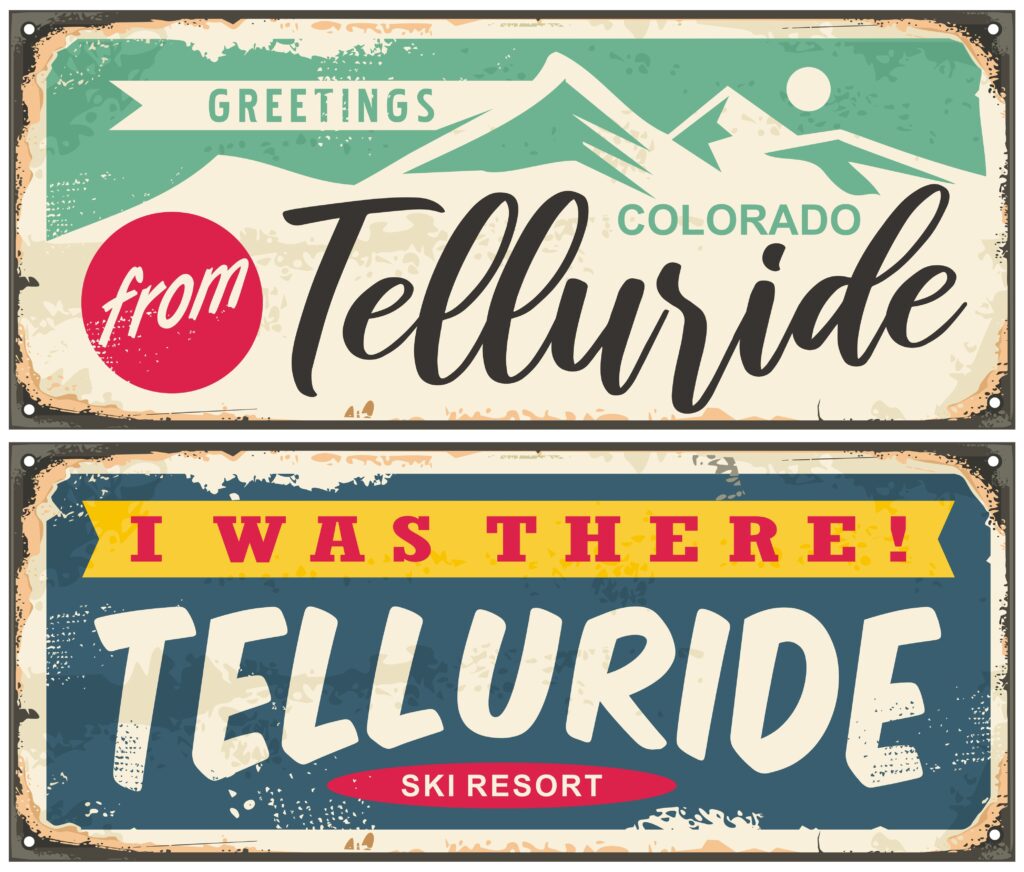
But what makes Telluride truly special is the accessibility to backcountry areas. There are plenty of options for extended backcountry trips in the surrounding mountains. Set up camp, then explore terrain that’ll make your heart race. Check the avalanche conditions and have the proper safety equipment before venturing into these wilds.
Red Mountain Pass: High-Alpine Bliss
Red Mountain Pass is your spot for those seeking solitude and a taste of high-alpine adventure. This place is a haven for backcountry enthusiasts, and for good reason. The terrain is incredibly diverse, with open bowls, steep chutes, and gladed areas. The views from this high-altitude gem are nothing short of spectacular.
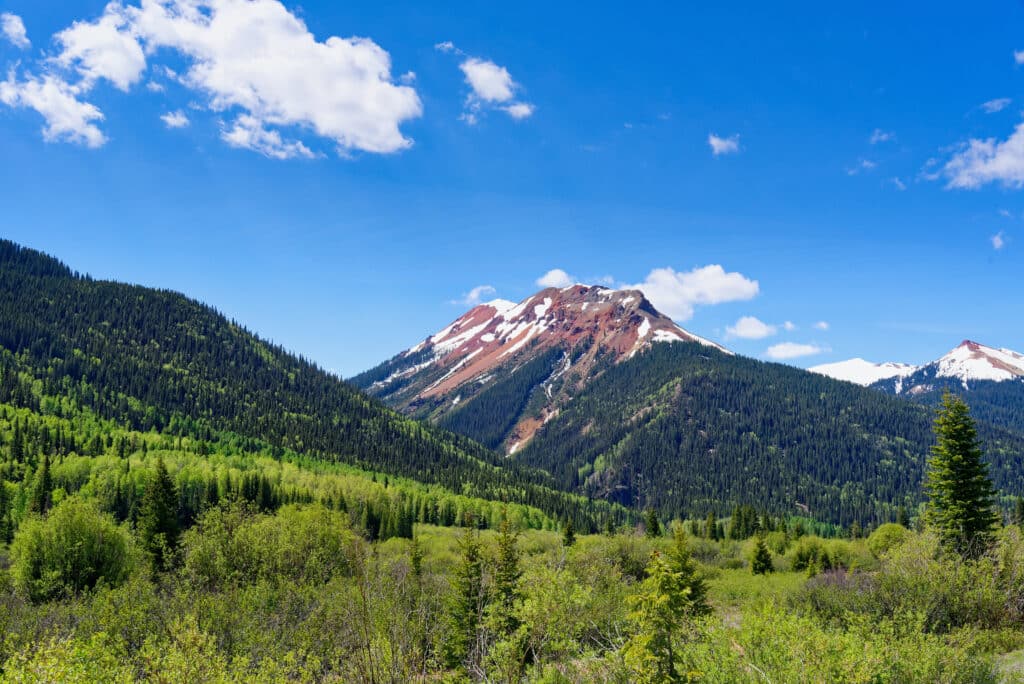
A big plus of Red Mountain Pass is that it’s less crowded than some other Colorado skiing destinations. You can often have the entire mountainside to yourself. Imagine carving fresh tracks in the serene wilderness, surrounded by towering peaks and a canopy of bluebird skies. It’s an experience that’s simply unbeatable.
Silverton Backcountry: The Ultimate Challenge
If you’re a thrill-seeker looking for the ultimate challenge, head to Silverton. The Silverton Backcountry is renowned for its extreme terrain and jaw-dropping descents. This is where experienced backcountry skiers come to test their skills and courage.
This area is not for the faint of heart. Steep slopes, tight couloirs, and deep powder are the norm here. The upside? The untouched snow is incredibly light and dry, perfect for those legendary powder days.
But don’t underestimate the demands of Silverton. The rugged, remote terrain requires strong backcountry skills and preparation. Hiring a guide is highly recommended if you’re unfamiliar with the area. Safety should always be the priority when tackling this extreme terrain.
Camping in the San Juans: The Wild Side of Winter
Regarding camping in the San Juan Mountains, you’ll find options as diverse as the terrain. From rustic campsites to more developed campgrounds, there’s something for every adventurer. If you’re more of a wilderness enthusiast, there are ample opportunities for backcountry camping. Just follow the Leave No Trace principles to protect this pristine environment.
Imagine settling down in a cozy tent beneath a star-studded sky, with the snow-covered peaks looming in the distance. The serenity of the San Juans at night is a memory you’ll cherish forever.
Whether you’re looking for a day of heart-pounding runs, a serene night under the stars, or a week-long backcountry expedition, the San Juan Mountains in southwestern Colorado have it all. The Telluride area, Red Mountain Pass, and the Silverton backcountry are just a taste of the adventures that await you in this winter wonderland.
So, gear up and get ready to discover the backcountry skiing and camping paradise of the San Juan Mountains. It’s a journey you won’t soon forget.
Sierra Nevada, California
The Sierra Nevada range is famous for its backcountry skiing opportunities. Spots like Lake Tahoe, Mammoth Lakes, and the Eastern Sierra offer various terrain and camping options.
If you’re a snow-loving adventurer, and you must be if you’re reading this, California’s Sierra Nevada range is a dream destination. Known for its world-class backcountry skiing and breathtaking landscapes, this region offers outdoor enthusiasts a chance to carve through a winter wonderland.
From the iconic Lake Tahoe to the Eastern Sierra’s hidden gems, let’s explore this stunning range’s backcountry skiing and camping opportunities.
Lake Tahoe: A Winter Playground
Lake Tahoe is a name that resonates with skiers and snowboarders worldwide. The region is a winter playground with some of the best resorts in the country, but it’s also a gateway to remarkable backcountry skiing opportunities.

You can start your day at a Lake Tahoe ski resort and then venture into the backcountry when ready for adventure. Whether you’re a seasoned expert or a newcomer, there’s terrain to match your skills. The combination of epic lake views and pristine snow-covered peaks is something you won’t forget.
Mammoth Lakes: Backcountry Bliss
Mammoth Lakes is another gem in the Sierra Nevada crown. Known for its abundant snowfall, this area is a haven for backcountry skiing enthusiasts. Mammoth Mountain offers everything from groomed slopes to exhilarating chutes, and the surrounding backcountry terrain is just as impressive.
Mammoth Lakes has it all, whether you’re into steep descents or open bowls. The region’s diverse terrain caters to a wide range of skiing abilities, so it’s an excellent choice for groups with varying skill levels.
When it comes to camping, Mammoth Lakes boasts a true backcountry experience. With the towering peaks and vast, snowy landscapes as your backdrop, you’ll be in awe of the natural beauty surrounding you.
Eastern Sierra: A Hidden Paradise
For those in the know, the Eastern Sierra is a hidden paradise waiting to be explored. This region, often less crowded than other Sierra Nevada destinations, offers pristine wilderness and superb backcountry skiing.
From the breathtaking views in the John Muir Wilderness to the challenging slopes in the Hoover Wilderness, you’ll find terrain as challenging as it is rewarding. The quiet solitude and raw beauty of the Eastern Sierra make it an ideal destination for those looking to escape the crowds and enjoy nature in its purest form.
Camping in the Eastern Sierra is a unique experience. You’ll find both established campgrounds and more primitive sites along the way. These campgrounds are typically less crowded than those around Lake Tahoe or Mammoth Lakes, so you can fully immerse yourself in the stunning wilderness surroundings.
California’s Sierra Nevada range is a haven for backcountry skiing and camping. From Lake Tahoe’s iconic beauty to Mammoth Lakes’ diverse terrain and the Eastern Sierra’s hidden gems, there’s something here for every winter adventurer. So, pack your gear, prepare for a snowy journey, and get ready to experience the magic of the Sierra Nevada’s backcountry. It’s a winter paradise just waiting for you to explore.
Teton Range, Wyoming
Grand Teton National Park and the surrounding area provide ample backcountry skiing and winter camping opportunities. The Teton Pass and surrounding areas are popular destinations.
With its rugged peaks and stunning vistas, Wyoming’s Teton Range is a backcountry enthusiast’s dream come true. Grand Teton National Park and the surrounding areas offer ample opportunities for those who seek adventure in the heart of winter. From carving fresh tracks on the Teton Pass to cozy winter camping experiences, let’s delve into backcountry skiing and camping in this iconic region.
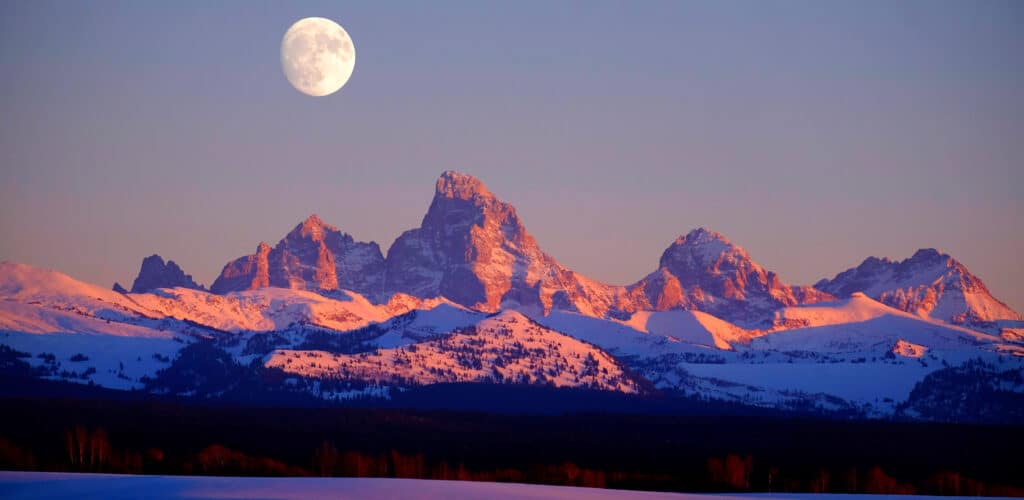
Grand Teton National Park: A Snow-Covered Wonderland
First up on our adventure is Grand Teton National Park. Famous for its awe-inspiring mountains, this park transforms into a snow-covered wonderland in winter. If you want to experience the essence of the Tetons, the park is the place to start.
The Tetons provide a pristine, challenging playground for backcountry skiers. From the iconic Teton Glacier to Death Canyon, there’s no shortage of epic runs to explore. But remember, the Tetons are not for the faint of heart – this is serious backcountry terrain. Be sure to check avalanche conditions, have the right gear, and consider hiring a local guide if you’re unfamiliar with the area.
Winter camping in Grand Teton National Park is a special experience. The park offers several campgrounds, some of which remain open during winter. Jenny Lake and Colter Bay campgrounds are great options for setting up your base camp, with snow-covered landscapes and the potential for wildlife sightings. Be prepared for chilly nights, and make sure you’re well-equipped for winter camping.
Teton Pass: The Local’s Secret
Just outside Grand Teton National Park lies Teton Pass, a local’s secret and a mecca for backcountry skiing. This area is beloved by locals and known for its accessibility and diverse terrain. Teton Pass is perfect for those who want to experience the beauty of the Tetons without venturing too deep into the backcountry.
The slopes around Teton Pass offer a wide range of experiences. You’ll find plenty of options whether you’re an intermediate skier or an advanced backcountry enthusiast. The Pass also provides a unique blend of accessibility and adventure, making it an excellent choice for those looking to combine day trips with winter camping.
Winter camping around Teton Pass is an authentic experience. You can find dispersed camping spots in nearby national forests, a great way to immerse yourself in the wilderness. Be sure to bring your camping gear, as facilities in this area are minimal.
Safety First: Backcountry Considerations
As you embark on your backcountry skiing and winter camping adventure in the Tetons, remember that safety should always be your top priority. The terrain here can be unforgiving, and avalanche conditions can change rapidly.
Before you go, you must check avalanche forecasts and be equipped with avalanche safety gear. If you’re new to backcountry skiing, consider taking an avalanche safety course or hiring a local guide who knows the terrain.
When camping in the Tetons during winter, it’s crucial to be prepared for frigid temperatures and potentially harsh weather conditions. Insulated sleeping gear and cold-weather clothing are a must. Ensure you’re well-informed about park regulations and always practice Leave No Trace principles to preserve the beauty of this pristine environment.
The Tetons in Wyoming offer a winter wonderland for backcountry skiing and camping enthusiasts. Grand Teton National Park and Teton Pass are prime destinations for exploring this breathtaking region. Just remember to be well-prepared, stay safe, and soak up the incredible natural beauty of the Tetons. Happy trails and powdery slopes await you!
Montana’s Glacier National Park
Glacier National Park offers pristine wilderness and incredible skiing opportunities. The Going-to-the-Sun Road and surrounding backcountry areas are popular choices.
When you think of Montana’s Glacier National Park, you might conjure up images of jaw-dropping landscapes, pristine wilderness, and the call of the wild. But did you know this breathtaking national park is not just a summer wonderland? Winter transforms it into a serene, snow-covered playground, and it’s an off-the-beaten-path paradise for backcountry skiing enthusiasts.
From cruising along the famous Going-to-the-Sun Road to venturing into the park’s surrounding backcountry, let’s dive into the world of backcountry skiing in Glacier National Park.
Glacier National Park: A Winter Wonderland
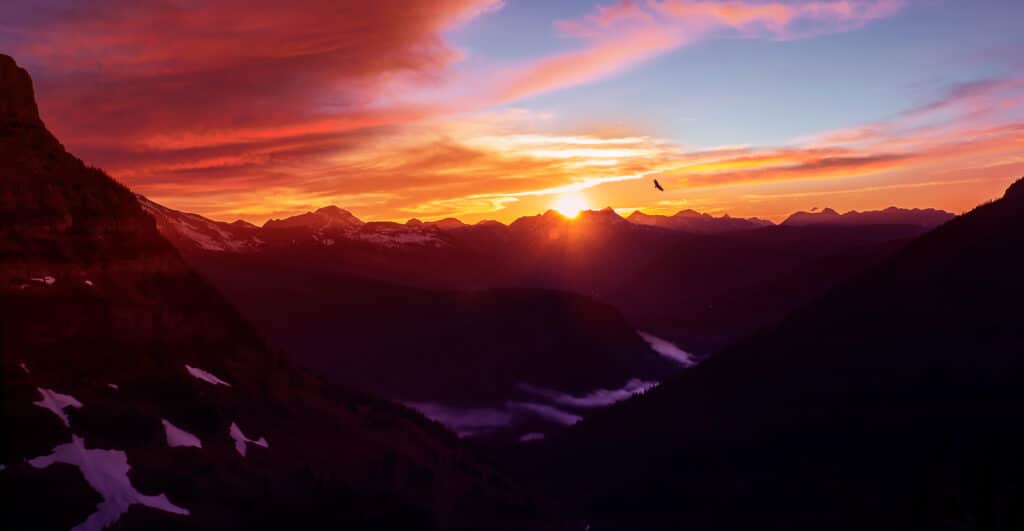
Glacier National Park, known for its dramatic mountain scenery, becomes even more enchanting when the snow blankets its rugged peaks and dense forests. While summer sees hikers and campers, winter brings skiers and snow lovers to the park.
One of the most iconic aspects of winter in Glacier National Park is the peace and tranquility that blankets the landscape. The crowds of summer are gone, leaving you with a sense of solitude amidst the snow-covered terrain. The scenery, untouched by the throngs of tourists, feels almost otherworldly.
Going-to-the-Sun Road: A Scenic Snow-Covered Route
In the winter, the famous Going-to-the-Sun Road is closed to vehicles, making it a fantastic route for skiers and snowshoers. This road, known for its breathtaking views during the summer, transforms into a serene snow-covered pathway during the winter.
Skiing or snowshoeing along the Going-to-the-Sun Road offers an experience like no other. The snow-covered trees and dramatic peaks create a surreal winter wonderland. Plus, you’ll have the road mostly to yourself, fully immersing yourself in the park’s natural beauty.
Surrounding Backcountry: Untamed Wilderness
While the Going-to-the-Sun Road is a popular winter route in Glacier National Park, the real adventure begins when you venture into the surrounding backcountry. The park offers an array of backcountry skiing opportunities, catering to a variety of skill levels.
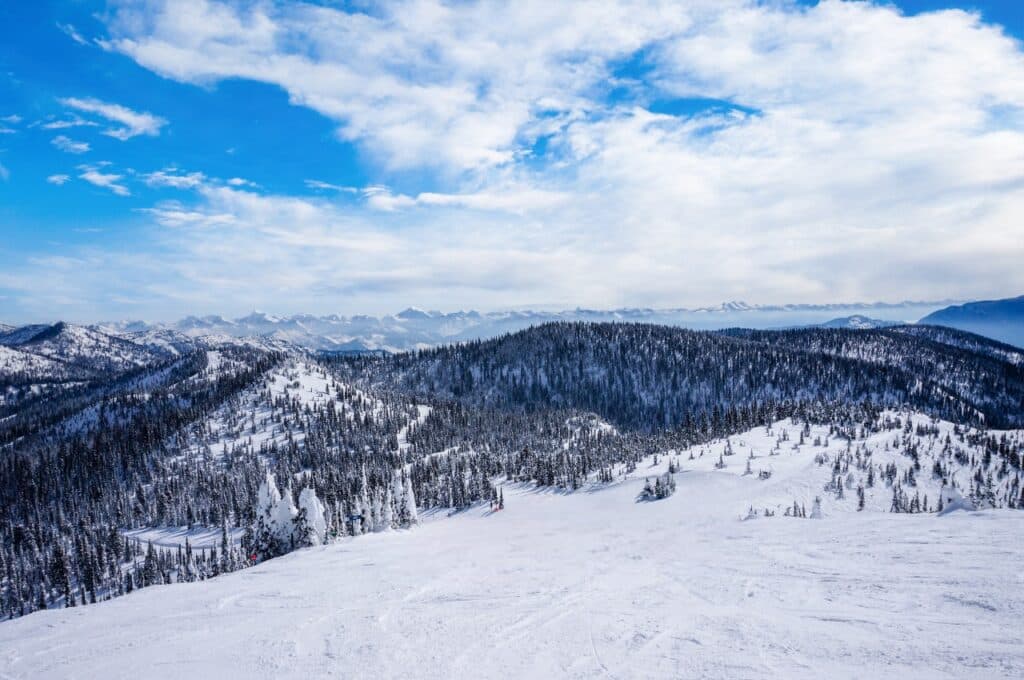
From gentle, rolling hills to challenging, steep slopes, you’ll find terrain that suits your abilities. Some areas are perfect for novice skiers, while others provide a thrilling experience for experts. The untouched snow, pristine wilderness, and crisp mountain air combine to create an unforgettable backcountry skiing experience.
But remember, safety should always be a priority in Glacier’s backcountry. Before setting out, check avalanche conditions and ensure you have the necessary safety gear. If you’re new to backcountry skiing, consider hiring a local guide who knows the terrain and can lead you safely through the wilderness.
Winter Camping: Cozy Nights in the Snow
Consider winter camping if you want to extend your Glacier National Park adventure. The park offers camping opportunities, even during the winter months, allowing you to experience the magic of the snowy landscape up close.
Camping in Glacier National Park during winter is a unique experience. Imagine cozying up in a tent under a star-studded sky, with the snow-covered peaks as your backdrop. Remember that winter camping requires proper gear to stay warm, and it’s essential to follow Leave No Trace principles to preserve the park’s pristine wilderness.
Montana’s Glacier National Park is a hidden gem for backcountry skiing and winter adventure enthusiasts. Whether you’re gliding along the Going-to-the-Sun Road or exploring the surrounding backcountry, the park’s serene, snow-covered wilderness offers a magical experience. So, gear up, be prepared, and ski through paradise in Glacier National Park. It’s an off-season wonderland just waiting to be explored.
Utah’s Wasatch Mountains
The Wasatch Range, near Salt Lake City, is known for its deep powder and accessible backcountry terrain. Consider skiing and camping around Little Cottonwood Canyon and Big Cottonwood Canyon.

If you’re a winter sports enthusiast seeking deep powder and a pristine backcountry experience, look no further than Utah’s Wasatch Mountains. Located just a stone’s throw away from Salt Lake City, this range is renowned for its accessible backcountry terrain. It is a top destination for those searching for thrilling downhill runs and unforgettable camping experiences.
Join us as we explore the winter wonderland around Little Cottonwood Canyon and Big Cottonwood Canyon in the Wasatch Mountains.
The Wasatch Mountains: A Skier’s Paradise
The Wasatch Mountains are a playground for skiers and snowboarders, and their reputation for deep, legendary powder is well-deserved. While the area boasts world-class resorts like Alta, Snowbird, Brighton, and Solitude, the backcountry terrain truly sets the Wasatch Mountains apart.
With the proximity of Salt Lake City, it’s easy to base your adventures here. You can explore the backcountry and camp under the stars for many hours, a dream come true for many winter enthusiasts.
Little Cottonwood Canyon: A Backcountry Haven
Little Cottonwood Canyon is a mecca for backcountry skiing in the Wasatch Mountains. With its impressive annual snowfall and accessible terrain, it’s no wonder that seasoned and novice backcountry enthusiasts alike flock to this area.
The terrain here is diverse, offering options for all levels of skiers and snowboarders. From mellow glades to challenging couloirs, Little Cottonwood Canyon has it all. Popular routes like White Pine, Red Pine, and Catherine’s Pass provide thrilling descents and jaw-dropping scenery.
Camping options in Little Cottonwood Canyon include developed campgrounds and dispersed camping opportunities. Whether you prefer the convenience of a campground or the solitude of the wilderness, you can find a spot to rest your head and prepare for another day of backcountry adventures.
Big Cottonwood Canyon: Winter Magic Awaits
Neighboring Big Cottonwood Canyon is another gem in the Wasatch Mountains, offering a slightly different flavor of backcountry skiing. With well-known resorts like Brighton and Solitude, the area attracts skiers and snowboarders looking for a blend of resort and backcountry skiing.
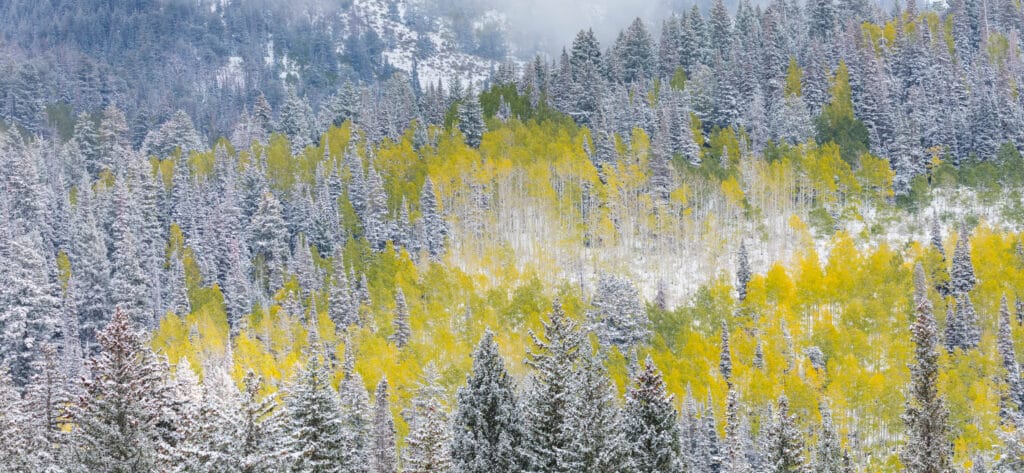
Big Cottonwood Canyon also boasts some exceptional backcountry routes, including areas like Cardiff Fork, Mill B South, and Silver Fork. These areas provide a mix of beginner-friendly and challenging terrain, making it an excellent choice for groups with varying skill levels.
Camping in Big Cottonwood Canyon is as inviting as in its smaller neighbor. Developed campgrounds and opportunities for dispersed camping are available, providing various options to suit your preferences.
Safety First: Backcountry Wisdom
Before you venture into the Wasatch Mountains’ backcountry, it’s essential to prioritize safety. This region is known for its challenging terrain and changing weather conditions, so come prepared.
Check avalanche conditions and have the necessary safety gear, including a beacon, shovel, and probe. If you’re new to backcountry skiing, consider taking an avalanche safety course or hiring a local guide to ensure a safe and enjoyable experience.
Winter Camping: Embracing the Cold
Camping in the Wasatch Mountains during the winter months can be an exhilarating experience. Imagine spending the night surrounded by snow-covered peaks and waking up to the promise of fresh tracks in the backcountry.
Ensure you’re well-equipped for cold nights by having the right camping gear, including a cold-weather sleeping bag and clothing. Pay attention to Leave No Trace principles to protect this pristine environment, and always check local regulations before setting up camp.
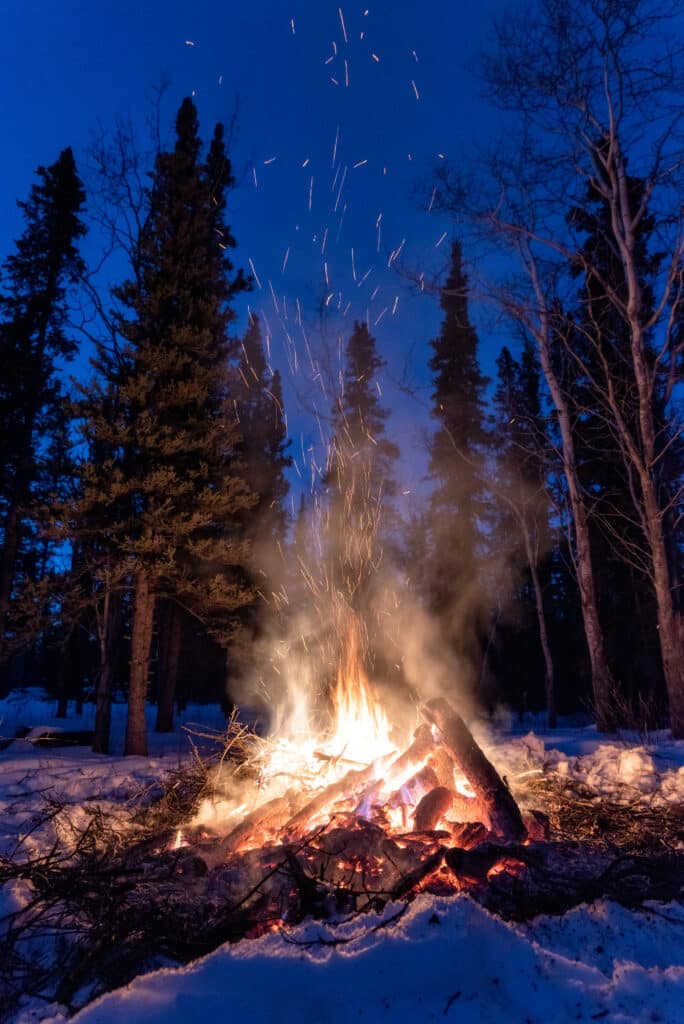
Utah’s Wasatch Mountains offer a winter playground for backcountry skiing and camping enthusiasts. Whether carving through the powder in Little Cottonwood Canyon or exploring the diverse terrain of Big Cottonwood Canyon, this region is a dream come true for winter adventurers.
So, gear up, stay safe, and get ready to chase powder dreams in the beautiful Wasatch Mountains. It’s a winter wonderland waiting to be explored.
Washington’s North Cascades
The North Cascades offer rugged and remote terrain for backcountry skiing. Locations like the Mt. Baker area and North Cascades National Park are popular destinations.
Nestled in the heart of the Pacific Northwest, Washington’s North Cascades are a well-kept secret among backcountry skiing enthusiasts.
This rugged and remote terrain offers some of the most thrilling and pristine skiing experiences in the United States. With iconic destinations like the Mt. Baker area and North Cascades National Park, it’s time to unlock the secrets of this remarkable backcountry skiing paradise.
The North Cascades: Rugged Wilderness Awaits
If you’re seeking a winter adventure that includes breathtaking landscapes, untouched powder, and an air of pure solitude, the North Cascades are the place to be. Unlike their more famous counterparts in the Rockies, the North Cascades offer a quieter, more rugged experience for backcountry skiers.
The region is characterized by its towering peaks, dense forests, and deep snowpack, making it a haven for adventurous skiers and snowboarders. While the terrain can be challenging, the rewards are unparalleled, with endless opportunities for thrilling descents and jaw-dropping views.
Mt. Baker Area: A Backcountry Gem
The Mt. Baker area is one of the most well-known destinations in the North Cascades for backcountry skiing. Home to Mt. Baker Ski Area, this region is a treasure trove for winter adventurers.
Mt. Baker Ski Area is famous for its deep powder, with an average annual snowfall that rivals almost any ski resort worldwide. But what makes this area truly special is the accessibility to some of the finest backcountry terrain. The nearby Mt. Baker-Snoqualmie National Forest and North Cascades National Park offer endless opportunities to explore the wilderness beyond the resort.
From the moderate terrain of Table Mountain to the challenging chutes of Shuksan Arm, there’s a diverse range of terrain suitable for all levels of skiers. The sheer variety ensures that both novice and expert skiers can enjoy their share of adventure.
North Cascades National Park: A Wilderness Playground
Beyond the Mt. Baker area, North Cascades National Park provides a vast and pristine wilderness for backcountry enthusiasts. This national park is a remote haven for those who appreciate the true essence of the great outdoors.
The park features extensive alpine terrain, breathtaking summits and vast glaciers that promise unparalleled skiing experiences. Popular routes include the challenging Forbidden Tour, where the views are as rewarding as the descents, and the more approachable Sahale Arm.

As you venture into North Cascades National Park, you must be self-reliant, well-prepared, and ready to embrace the wilderness. Backcountry safety is paramount, as is an understanding of the changing weather conditions and avalanche risks. Always check for permits and current park regulations, as the wilderness in this park is carefully protected.
Winter Camping: A Night Under the Stars
What better way to extend your North Cascades adventure than camping in this pristine wilderness? Winter camping in the North Cascades is a magical experience, with snow-covered peaks and star-studded skies as your companions.
While campgrounds may be limited in the winter, the backcountry offers many opportunities. Be sure to equip yourself with cold-weather camping gear, including a warm sleeping bag and proper clothing. Practicing Leave No Trace principles is essential to protect this unspoiled environment.
Washington’s North Cascades are a backcountry skiing paradise, offering rugged terrain and remote wilderness for those willing to venture off the beaten path. This region promises unparalleled skiing adventures from the renowned Mt. Baker area to the pristine North Cascades National Park.
So, gear up, embrace the solitude, and prepare for an epic backcountry journey in the North Cascades. It’s a world of pristine beauty just waiting to be explored.
Idaho’s Sawtooth Range
The Sawtooth Range in central Idaho provides stunning scenery and excellent backcountry skiing. Consider camping near Stanley or Redfish Lake.
Regarding epic backcountry skiing and camping adventures, Idaho’s Sawtooth Range is a hidden gem waiting to be explored. Nestled in central Idaho, the Sawtooth Range offers skiers pristine, unspoiled wilderness and picturesque alpine terrain.
From breathtaking descents to tranquil camping near Stanley or the famous Redfish Lake, this region has it all for those seeking the perfect blend of adventure and serenity.
The Sawtooth Range: Nature’s Masterpiece
The Sawtooth Range is a slice of alpine paradise, boasting jagged peaks, lush forests, and pristine lakes. It’s a mecca for backcountry enthusiasts seeking untouched powder and striking scenery. Unlike crowded ski destinations, the Sawtooth Range offers a quieter, more intimate connection with the mountains.
What sets this region apart is its untamed beauty. The mountains are graced with rugged cliffs, and the high-altitude lakes are like glistening gems nestled in the vast wilderness. The Sawtooths provide a playground for experienced backcountry skiers and those looking to explore the sport for the first time.
Camping Near Stanley: A Wilderness Escape
Stanley, Idaho, is your gateway to the wonders of the Sawtooth Range. This charming town, often called the “Gateway to the Sawtooths,” is an excellent base for your backcountry skiing and camping adventure.
Camping near Stanley allows you to wake up amidst this pristine wilderness, with various camping options available. Stanley Lake, Redfish Lake, and Iron Creek Campground are popular choices. These sites offer everything from basic amenities to more remote camping experiences.
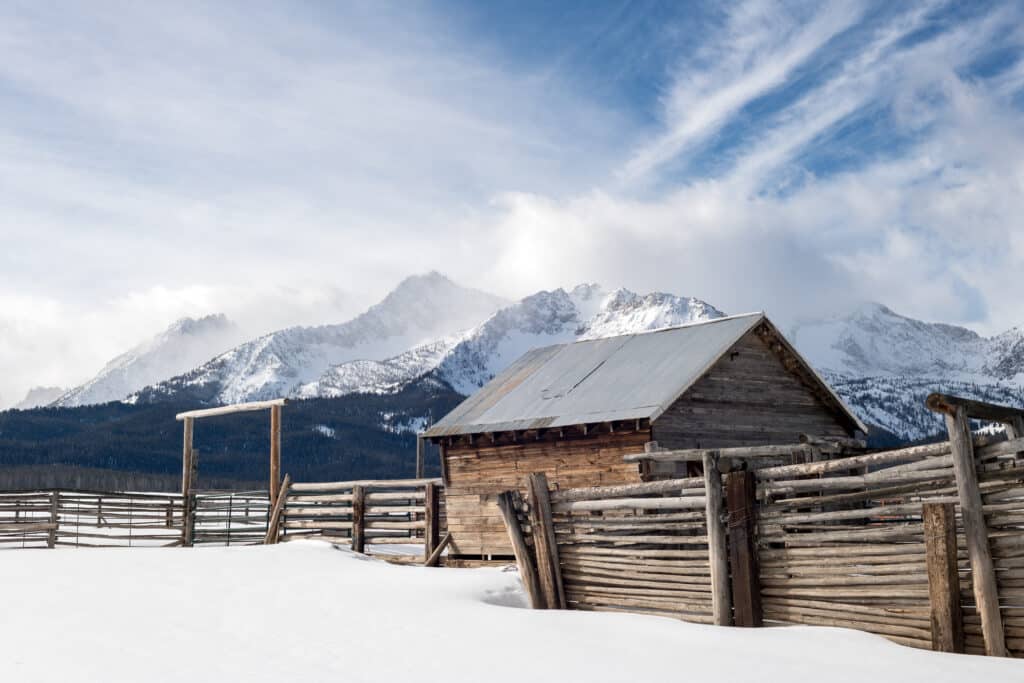
Picture yourself waking up to the sun rising over the jagged Sawtooth peaks, with a hot cup of coffee in hand, preparing for a day of exhilarating backcountry skiing. Stanley, surrounded by the beauty of the Sawtooth Range, offers a true wilderness escape.
Redfish Lake: An Iconic Destination
Redfish Lake is a true icon of the Sawtooth Range. It’s known for its crystal-clear waters and the stunning alpine backdrop of the mountains. The lake is a breathtaking setting and an ideal location for various outdoor activities, including backcountry skiing.
Consider setting up your base camp at one of the campgrounds near Redfish Lake. Here, you’re surrounded by the majestic peaks of the Sawtooth Range, making it the perfect launchpad for your backcountry skiing excursions.
Skiers can explore the alpine slopes near Redfish Lake, offering an exciting blend of terrain, from gentle slopes for beginners to challenging chutes for experts. The quiet, untouched powder and awe-inspiring scenery make this region an excellent choice for winter adventurers.
Safety and Preparedness: A Backcountry Must
As you venture into the Sawtooth Range for backcountry skiing and camping, it’s crucial to prioritize safety and preparedness. This region’s remote and challenging terrain demands respect and caution.
Before you embark on your skiing adventures, check avalanche conditions and carry the necessary safety equipment, such as an avalanche beacon, shovel, and probe. If you’re new to backcountry skiing, consider taking an avalanche safety course to ensure your safety.
When camping in the Sawtooth Range during winter, it’s vital to have the right gear to stay warm in the cold nights. Follow Leave No Trace principles to protect the region’s pristine beauty and respect all local regulations.
In summary, Idaho’s Sawtooth Range is a backcountry skiing and camping haven, offering stunning scenery, untamed wilderness, and the thrill of deep powder. Camping near Stanley or Redfish Lake is ideal for immersing yourself in this pristine environment and making the most of your backcountry adventure.
Gear up, stay safe, and prepare for a unique experience in the wild beauty of the Sawtooth Range. It’s a paradise for those who seek serenity and excitement in the heart of Idaho’s wilderness.
Oregon’s Mt. Hood
Mt. Hood offers great skiing options and a variety of camping locations. The Timberline area is a well-known starting point for backcountry skiing trips.
As winter sweeps over Oregon, there’s a magical transformation underway on the slopes of Mt. Hood. This iconic peak, known for its year-round skiing options, is a treasure trove for backcountry enthusiasts. From thrilling runs to the myriad camping spots that dot its terrain, Mt. Hood offers a ski and camping experience like no other.
Let’s embark on a virtual journey to explore the snowy wonders of this Pacific Northwest gem, with the Timberline area as our starting point.

Mt. Hood: An Oregon Landmark
Standing tall at over 11,000 feet, Mt. Hood dominates the Oregon landscape and beckons skiers, snowboarders, and mountaineers year-round. Its pristine slopes and diverse terrain make it a quintessential destination for winter sports enthusiasts.
During the ski season, Mt. Hood boasts a variety of skiing options, but the backcountry terrain truly sets this mountain apart. Its proximity to Portland makes it a convenient yet remarkable location for those searching for adventure.
Timberline Lodge: A Fabled Starting Point
The Timberline Lodge, an architectural masterpiece and a historic landmark, sits on the southern flank of Mt. Hood. This iconic lodge, perched at 6,000 feet, serves as a base for skiers and snowboarders and is a well-known starting point for backcountry adventures.
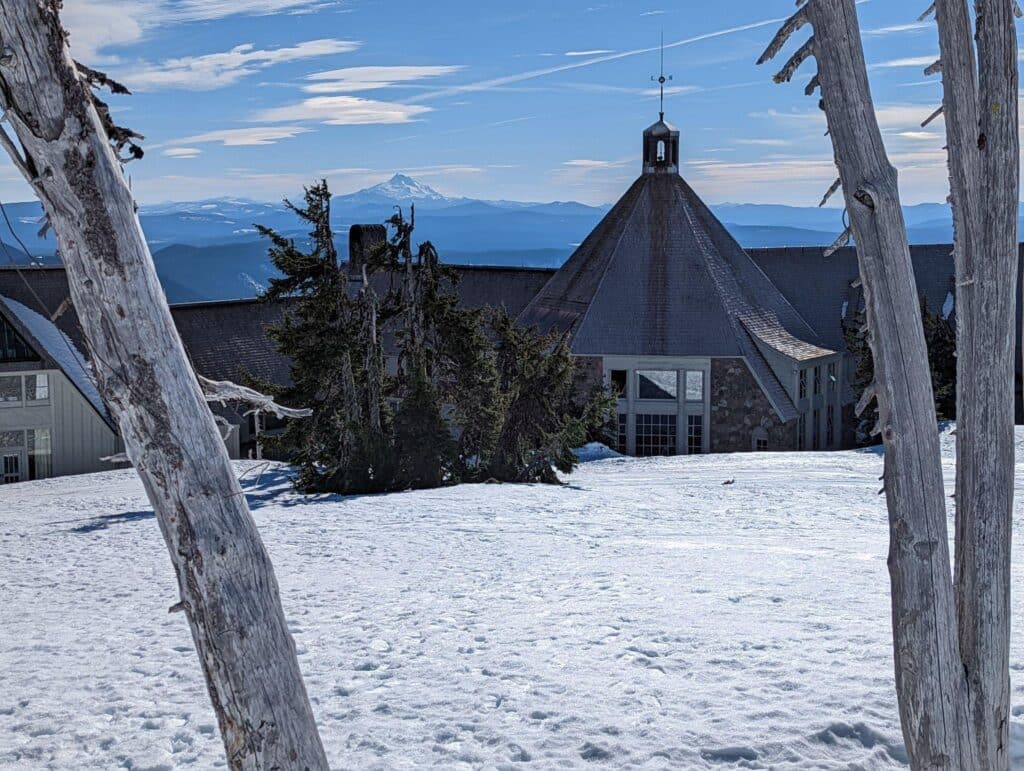
From Timberline, you can access a wide range of backcountry skiing opportunities. Whether you’re a seasoned backcountry explorer or new to the sport, there are slopes and routes to suit all skill levels. Timberline Lodge offers easy access to the Palmer Snowfield and the White River Canyon, with various exciting terrain for those willing to explore.
Winter Camping: A Night in the Wild
Camping near Mt. Hood is a wonderful way to immerse yourself in the natural beauty of this region. The mountain and its surroundings offer many camping options, from established campgrounds to backcountry sites. Winter camping here can be a magical experience, with the snow-covered landscape creating a serene backdrop for your adventures.
If you prefer established campgrounds, Trillium Lake, Clear Lake, and Timothy Lake Campgrounds are excellent options, providing facilities and amenities while allowing you to be close to the mountain. For those seeking a more remote experience, backcountry camping around Mt. Hood is a fantastic choice. Just remember to check local regulations and come prepared for cold winter nights.
Safety in the Backcountry
Safety is paramount when exploring the backcountry around Mt. Hood. The terrain can be challenging, and conditions can change rapidly, so being prepared and informed is essential. Before embarking on backcountry skiing adventures, check avalanche forecasts and equip yourself with essential safety gear, such as an avalanche beacon, shovel, and probe.
If you’re new to backcountry skiing, consider taking an avalanche safety course to learn the necessary skills and knowledge to navigate this terrain safely.
Skiing Opportunities Abound
The skiing opportunities around Mt. Hood are as diverse as they are exciting. From the stunning glades of Paradise Park to the thrilling descents of Mississippi Head, you’ll find something to suit every skiing style. The terrain is often deep with fresh powder, and the majestic views of the Cascade Range add an extra layer of magic to every descent.
Whether you’re carving down steep chutes or exploring gentle slopes, the Mt. Hood backcountry has something for everyone. As you traverse the mountain’s unspoiled terrain, you’ll be met with the hushed silence of the snowy wilderness, interrupted only by the swish of your skis on the pristine powder.
Oregon’s Mt. Hood offers various backcountry skiing options and camping locations, all within a stone’s throw of Portland. From the Timberline Lodge, skiers and snowboarders can access the mountain’s incredible backcountry terrain, with diverse routes for various skill levels.
Add the opportunity to camp amidst the snowy beauty, and you have the makings of an unforgettable winter adventure. So, gear up and explore the wonders of Mt. Hood for yourself—it’s a backcountry skier’s paradise waiting to be discovered.
Nevada’s Ruby Mountains
The Ruby Mountains in northeastern Nevada offer a lesser-known yet fantastic backcountry skiing experience. Lamoille Canyon is a popular entry point for backcountry enthusiasts.
Regarding backcountry skiing, the first destinations often come to mind are Colorado, Utah, or the Pacific Northwest. But tucked away in the northeastern corner of Nevada lies a hidden treasure for winter enthusiasts—the Ruby Mountains.
Offering a lesser-known yet fantastic backcountry skiing experience, with Lamoille Canyon as the gateway, the Ruby Mountains are ready to surprise you with their stunning landscapes and thrilling runs.
The Ruby Mountains: Nevada’s Best-Kept Secret
The Ruby Mountains, also known as the “Rubies,” may not be as famous as other mountain ranges in the West, but their unique charm and pristine wilderness make them a hidden gem for backcountry skiing. This unspoiled mountain range offers the solitude and serenity many winter adventurers seek.
The Rubies are a sub-range of the larger Great Basin Ranges, and they’re named for the reddish hue that their peaks take on during the alpenglow of sunrise and sunset. With elevations reaching over 11,000 feet, the Rubies provide an impressive backdrop for skiing and outdoor exploration.
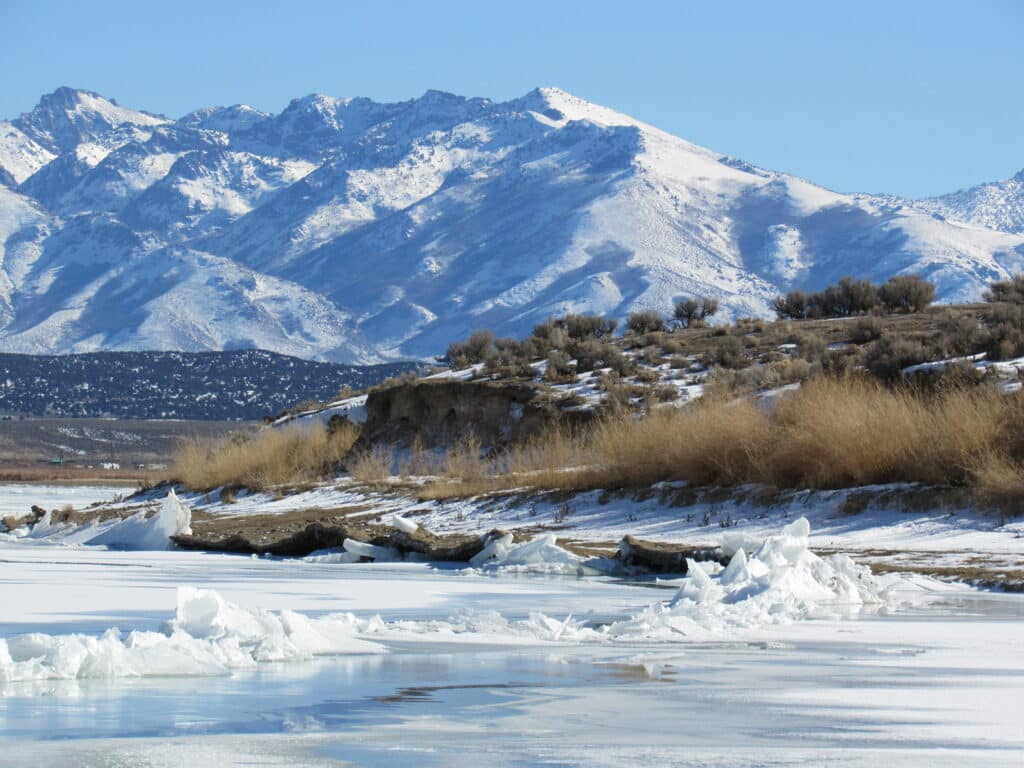
Lamoille Canyon: The Backcountry Gateway
Lamoille Canyon, located within the Ruby Mountains, is a well-known entry point for backcountry skiing adventures. The canyon serves as a portal to the spectacular terrain that awaits skiers and snowboarders in the Rubies.
The sheer beauty of Lamoille Canyon is breathtaking in its own right, making it the ideal starting point for any adventure. The towering cliffs, frozen waterfalls, and snow-covered peaks create a mesmerizing winter wonderland that beckons skiers to explore.
Backcountry Skiing Adventures
While the Ruby Mountains may not have the same level of recognition as some other ski destinations, they offer a diverse range of skiing experiences for backcountry enthusiasts. The terrain caters to various skill levels, from beginners to experts.
Experienced backcountry skiers can take on the challenges of more advanced routes, such as Liberty Pass or 10,308 Pass, which provide thrilling descents in untouched powder. For those new to the sport, the Rubies offer gentler slopes and open bowls where you can hone your skills and take in the incredible scenery.
The pristine, untracked snow and seclusion set the Ruby Mountains apart. As you carve down the slopes, you’ll feel like you have the mountain all to yourself, creating a truly immersive experience in the backcountry.
Safety and Preparedness
As with any backcountry skiing adventure, safety is paramount in the Ruby Mountains. The terrain can be challenging, and the remote location can present unique risks. Before you embark on your journey, check avalanche conditions and carry the necessary safety equipment, including an avalanche beacon, shovel, and probe.
If you’re new to backcountry skiing, consider taking an avalanche safety course to gain the knowledge and skills required for safe exploration. Safety should always be the top priority when enjoying the backcountry.
Camping in the Rubies
Camping opportunities are plentiful in and around Lamoille Canyon. While camping in the heart of the Ruby Mountains can be a bit more rustic, the experience is well worth it for those seeking true immersion in the winter wilderness.
Whether camping in a developed campground or venturing into the backcountry, you’ll be surrounded by the breathtaking beauty of the Ruby Mountains. Just be sure to check local regulations, have the right gear for cold winter nights, and follow Leave No Trace principles to protect the pristine environment.
Nevada’s Ruby Mountains are a hidden treasure for backcountry skiing enthusiasts. From the awe-inspiring beauty of Lamoille Canyon to the diversity of terrain awaiting skiers and snowboarders, the Rubies provide a lesser-known yet fantastic winter adventure. So, gear up, stay safe, and explore the hidden gem of the Ruby Mountains. It’s an unforgettable backcountry skiing experience waiting to be discovered.
California’s Lassen Volcanic National Park
Lassen Volcanic National Park in Northern California provides backcountry skiing and camping opportunities, particularly in the southern portion of the park.
When you think of California, images of palm trees and sun-soaked beaches might come to mind. Still, the Golden State also offers an entirely different kind of winter wonderland in the form of Lassen Volcanic National Park.
Nestled in the northern part of the state, this park is not just a summer paradise. Come wintertime, it becomes a haven for backcountry skiers and winter camping enthusiasts, particularly in the southern portion of the park. Let’s explore the magic of Lassen Volcanic National Park in winter.
Lassen Volcanic National Park: A Winter Oasis
Lassen Volcanic National Park is a hidden gem for winter adventurers. While it may not be as well-known as some national park counterparts, it boasts a unique blend of natural wonders, including hydrothermal areas, stunning lakes, and backcountry terrain for winter sports.
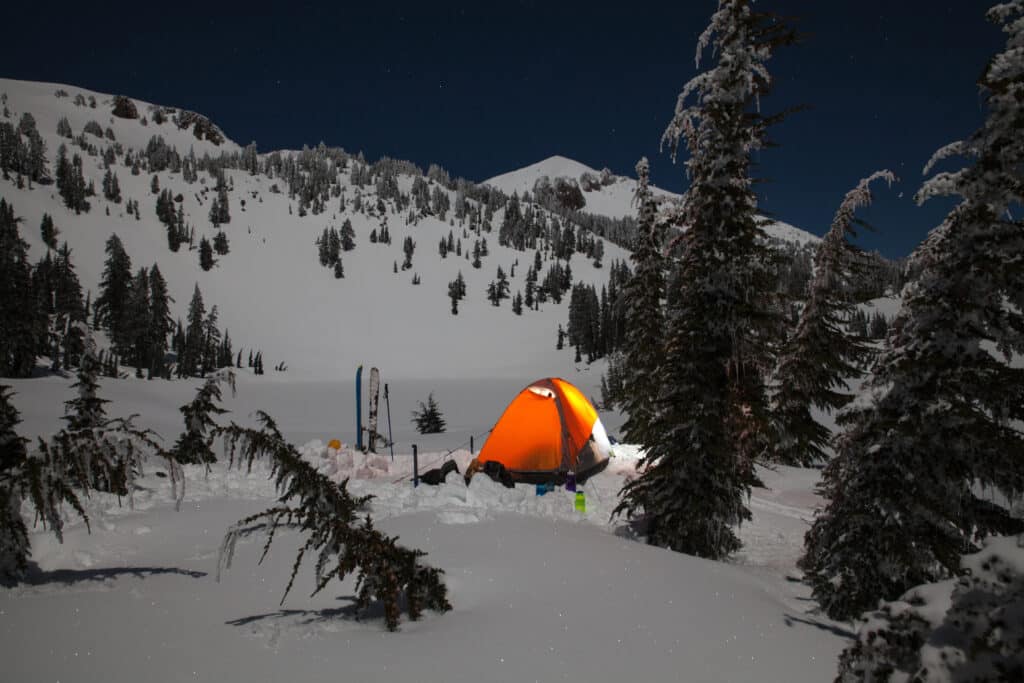
In the winter, the park becomes a serene and snow-covered playground, offering opportunities for cross-country skiing, snowshoeing, and backcountry skiing. With its distinctive volcanic landscape and pristine wilderness, Lassen Volcanic National Park is a winter oasis waiting to be explored.
Southern Portion of the Park: Your Backcountry Playground
The backcountry skiing and camping magic happens in the southern portion of Lassen Volcanic National Park. The Kohm Yah-mah-nee Visitor Center and the Lassen Peak Trailhead are popular starting points for backcountry adventures.
Lassen Peak, the park’s namesake, offers some exhilarating descents for backcountry skiers. The trail leading to the peak is known for its breathtaking views and challenging skiing terrain. The remarkable scenery and the feeling of skiing down an active volcano make this area a must-visit for those seeking an extraordinary winter adventure.
Winter Camping: A Night Under the Stars
Camping in Lassen Volcanic National Park during winter is an experience that shouldn’t be missed. With snow-covered landscapes, star-filled skies, and the promise of pristine mornings, it’s a true winter wonderland.
Camping facilities are available, and Manzanita Lake Campground is a popular choice for those looking to stay close to the action. Winter camping requires special gear, so ensure you’re well-prepared for the cold. Warm sleeping bags, suitable clothing, and other cold-weather gear are essential.
If you’re looking for a more remote experience, backcountry camping in the park is an option. Check local regulations, obtain necessary permits, and always practice Leave No Trace principles to protect the park’s natural beauty.
Safety First: Backcountry Essentials
As with any backcountry adventure, safety should be your top priority when exploring Lassen Volcanic National Park in the winter. The backcountry terrain can be challenging, and conditions can change rapidly.
Before starting your backcountry skiing adventure, you must check avalanche conditions and have the necessary safety equipment, including an avalanche beacon, shovel, and probe. If you’re new to backcountry skiing, consider taking an avalanche safety course to gain the skills and knowledge needed to navigate safely.
Skiing in Lassen Volcanic National Park
The backcountry skiing opportunities in the southern portion of the park are as diverse as they are exhilarating. With varying terrain, from open bowls to thrilling chutes and tree runs, Lassen Volcanic National Park offers something for skiers of all levels.
Whether carving through fresh powder on the slopes of Lassen Peak or gliding through the serene forests, the sense of solitude and the untouched beauty of the park create an unforgettable experience.
Lassen Volcanic National Park in Northern California is a hidden winter gem for backcountry skiing and camping enthusiasts. The southern portion of the park provides access to stunning backcountry terrain, where you can explore the unique volcanic landscape and enjoy thrilling descents.
So, gear up, stay safe, and discover the winter magic of Lassen Volcanic National Park. It’s a pristine wilderness just waiting to be explored.
Conclusion
The Western United States is a vast, diverse playground for backcountry skiing and camping enthusiasts. From the rugged beauty of the San Juan Mountains in Colorado to the pristine wilderness of Montana’s Glacier National Park, from the deep powder of Utah’s Wasatch Mountains to the serene landscapes of Washington’s North Cascades.
From the hidden gems of Nevada’s Ruby Mountains to the volcanic wonders of California’s Lassen Volcanic National Park, the region offers an array of winter adventures that cater to every level of expertise and various preferences.
As you explore these remarkable destinations, remember that safety is paramount in the backcountry. Always check avalanche conditions, have the necessary safety equipment, and consider taking an avalanche safety course if you’re new to backcountry skiing.
Additionally, winter camping can be an unforgettable experience, but it requires the right gear to stay warm and a commitment to Leave No Trace principles to protect the pristine environment.

Each of these regions offers a unique combination of stunning scenery, thrilling descents, and a sense of solitude that allows you to truly immerse yourself in the natural beauty of the Western United States.
Whether you’re cruising down the slopes of Mt. Hood in Oregon, carving through deep powder in the Wasatch Mountains of Utah, or exploring the remote terrain of the Ruby Mountains in Nevada, you’ll find a backcountry skiing and camping experience that will stay with you for a lifetime.
Gear up, stay safe, and embrace the sense of adventure that awaits in these remarkable destinations. The Western United States is a winter paradise for those who seek serenity, excitement, and the natural wonders of the great outdoors.
